HCF
& LCM Problems with Solutions Study Material
FACTORS
A number may be made by multiplying two or more other numbers
together. The numbers that are multiplied together are called factors of the
final number.
Factors of 12 = 1,2,3,4,6, and 12.
All the numbers have a factor of one.
Common
factor: A common factor of two or more given numbers is a number
which divides each given number completely. Common factor of 12 and 18 are
1,2,3,6.
Co-prime
numbers: Two or more numbers that do not have a common factor are
known as co-prime or relatively prime.
For example: 4 and 15 are Co-prime numbers.
Highest common factor: The highest common factor (H.C.F.) of two or more numbers is the greatest number which divides each of them exactly. It is also known as greatest common divisor (GCD.).
H.C.F. can be calculated by:
(i) Prime factorization method
(ii) Division method
(i) H.C.F. by prime factorization method:
Example 1:
Find the H.C.F. of 40 and 60 by prime factorization method.

∴ 40 = 2 × 2 × 2 × 5

∴ 60 = 2 × 2 × 3 × 5
Hence H.C.F. = 2 × 2 × 5 = 20.
Divide the greater number by the smaller number, divide the divisor by the remainder and so on, until no remainder is left. The last divisor in the required H.C.F,
Finding the H.C.F of more than two number We find the H.C.F of any two say P. How find the H.C.F of P and the third number and so on. The last H.C.F will be the required ,H.C.F.
(ii) H.C.F by Division method:
- Divide the greater number by the smaller number, divide the divisor by the remainder divide die remainder by the next remainder and so on, until no remainder is left, the last divisor is the required H.C.F.
- Finding the H.C.F of more than two number: we find the H.C.F of any two say P. Now find the H.C.F of P and the third number, and so on. The last H.C.F will be the required H.C.F.
H.C.F. of two numbers by division method:
Example 2:
Find the H.C.F. of 140 and 200 by division method.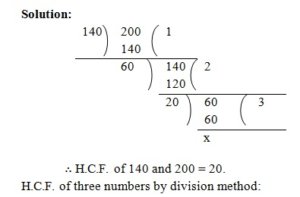
Example 3:
Find the H.C.F. of 324,630 and 342 by division method.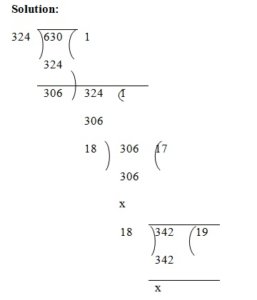
∴H.C.F. of324, 630 and 342 is 18.
H.C.F of polynomials:
When two or more-polynomials are factorised, the product of common factor is known as HCF of these polynomials.
e.g Lets find the HCF of 16x3 (x – 1)3 (x+ 1) and 4xy(x+ 1)2 (x- 1)
Now, 16x3 (x – l)3 (x+1) = 2×2×2×2×x×x×x×(x – l)× (x – 1) ×(x – 1) ×(x+ 1) and 4xy(x + l)2(x- 1) = 2 × 2xy (x + 1) (x +1) (x – 1)
∴H.C.F. = 2 × 2× x × (x + 1) (x – 1) = 4x (x2 –1)
MULTIPLES
Multiples of a number are all those numbers which can be divided completely by the given number.
For example, Multiples of 5 are 5,10,15,20 etc.
Common multiples: Common multiples of two or more numbers are the numbers which can be exactly divided by each of the given number.
For example, Multiples of 3 are 3,6,9,12,15,18,21,24 etc. and Multiples of 4 are 4,8,12,16,20,24,28 etc.
Common multiples of 3 and 4 are 12,24 etc.
Least common multiple: The least common multiple (L.C.M.) of two or more numbers is the smallest number which is exactly divisible by each of them
L.C.M. can be calculated by:
(i) Prime factorisation method
(ii) Division method
(i) L.C.M. by prime factorization method:
Example 4:
Find the L.C.M. of 12 and 20 by prime factorization method.
Solution:
12= 2×2×3 and 20 = 2×2×5
∴L.C.M =2 × 2 × 3 × 5 = 60.
(ii)L.C.M. by division method:
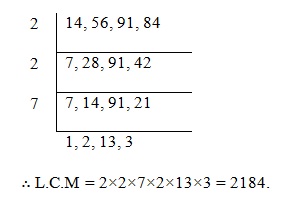
Example 5:
Find the L.C.M. of 14,56,91 and 84.
Solution:

L.CM of polynomials:
When two or more polynomials are factorised, the product of the factors with highest powers is the lowest common multiple (LCM) of the polynomials.
Eg. Consider the polynomials (x3– 8) and (x2– 4)
x3 – 8 = (x – 2) (x2 + 2x + 4)
and x2 – 4 = (x+2) (x-2)
∴ L.C.M = (x – 2) (x + 2) (x2 + 2x +4)
= (x +2) (x3 – 8)
H.C.F and L.C.M of FRACTIONS
First express the given fractions in their lowest terms.
Then,

Example 6:
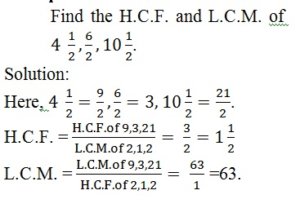
H.C.F. AND L.C.M. OF DECIMAL NUMBERS:
H.C.F of decimal numbers:
STEP I: Find the H.C.F of given numbers without decimal.
STEP II: Put the decimal point from right to left according to the maximum decimal places among the given numbers.
LCM of decimal numbers
STEP I: Find the L.C.M. of given numbers without decimal.
STEP II: Put the decimal point from right to left according to the minimum decimal places among the given numbers.
Example 7:
Find the H.C.F. and L.C.M. of 0.6,9.6 and 0.36.
Solution:
H.C.F of 60,96 and 36 = 12
∴Required HCF = 0.12
L.C.Mof60,96 and 36 = 1440
∴ Required L.C.M =144.0
The product of two numbers:
H.C.F. of numbers × L.C.M. of numbers = Product of numbers
Example 8:
If H.C.F. and L.C.M. of two numbers are 3 and 60 respectively and. one number is 12 then find the other number.
Solution:
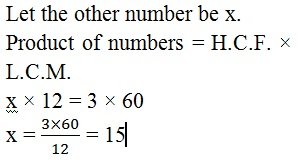
Remember
- The greatest number that will exactly divide x,y, z= H.C.F of x, y and z.
- The greatest number that will divide x, y and z leaving remainders a, b and c respectively =H.C.F of (x- a), (y -b) and (z – c).
- The least number which is exactly divisible by x, y and z. = L.C.M of x, y and z.
- The least number which when divided by x, y and z leaves the remainder a, b and c respectively= L.C.M of(x, y and z) – R where R=(x – a)=(y – b) = (z – c)
- The least number which when divided by x, y and z leaves the same remainder r in each case = L.C.M of (x, y and z)+r
- The greatest number that will divide x, y and z leaving the same remainder in each case = H.C.F of (x – y), (y – z) and (z- x).
- When two numbers P and Q are exactly divisible by a third number r. Then p + q, p – q and pq is also divisible by r.
Example 9:
The H.C.F of two numbers, each having three digits, is 17 and their L.C.M is 714.
Five sum of the numbers will be:
Solution: Let the number be 17x and 17y where x and y are co-prime. L.C.M of 17x and 17y =17xy According to question, 17xy-714
⇒xy=42=6 × 7
∴x=6and y = 7
or x = 7andy=6
First numbers = 17x = 17 × 6 = 102
Second numbers = 17y = 17×7 = 119
Required sum=102 + 119=221
Example 10:
Find the greatest number of six digits which on being divided by 6, 7, 8, 9 and 10 leaves 4, 5, 6, 7 and 8 as remainders respectively.
Solution:
The L.C.M. of 6, 7, 8, 9 and 10 = 2520
The greatest number of 6 digits = 999999 Dividing 999999 by 2520, we get 2079 as remainder. Hence the 6 digit number divisible by 2520 is 999999 -2079 = 997920
Since 6 – 4=2, 7 – 5 = 2, 8 – 6 = 2, 9 – 7 = 2,
10 – 8 = 2, the remainder in each case is less than the divisor by 2.
∴Required number = 997920 – 2 = 997918
Example 11:
What least number must be subtracted from 1936 so that the remainder when divided by 9, 10,15 will leave in each case the same remainder 7?
Solution:
The L.C.M. of 9,10 and 15 is 90.
On dividing 1936 by 90, the remainder =46
But 7 is also a part of this remainder.
∴Required number = 46 – 7 = 39.
Example 12:
Find the greatest number which will divide 410, 751 and 1030 leaving a remainder 7 in each case.
Solution:
Required number
= H.C.F. of (410 – 7), (751 – 7) and (1030 – 7)
= 31
Example 13:
Find the H.C.F and L.C.M of 1.75,5.6 and 7.
Solution:
Making the same number of decimal places, the numbers may be written as 1.75, 5.60 and 7.00.
Without decimal point, these numbers are 175,560 and 700.
Now, H.C.F of 175,560 and 700 is 35.
∴H.C.F of 1.75,5.6 and 7 is 0.35.
L.C.M of175,560 and 700 is 2800.
∴L.C.M of 1.75,5.6 and 7 is 28.00 i.e. 28.
COMPARISON OF FRACTIONS:
Rule: Convert each one of the given fractions in the decimal form. Now, arrange them in ascending or descending order, as per requirement

Example 15:
The H.C.F. of two polynomials is x2– 1 and their L.C.M is x4– 10x2+9. If one of die polynomials is x3– 3x2 – x + 3, find the other.
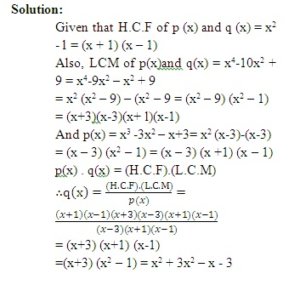
Example 16:
Find the H.C.F and L.C.M of 6,72 and 120, using the prime factorization method.
Solution:
We have: 6 =2 × 3, 72 = 23× 32, 120 = 23× 3 × 5
Here, 21 and 31 are the smallest powers of the common factors 2 and 3 respectively.
So, H.C.F(6,72,120) = 21× 31=2 × 3 = 6
23,32 and 51 are the greatest powers of the prime factors 2,
3 and 5 respectively involved in the three numbers. So, L.C.M(6,72,120)=23× 32× 51 =360.
Example 17:
Find the GCD of: 14x3+14, 42(x2 +4x+3)
(x2 -x+1)
Solution:
p(x)=14x3+14 = 14(x3+l) = 2 × 7(x+l)
(x2– x+l)
q(x)=42(x2 +4x+3)(x2 -x + l)
= 42(x2+3x+x+3)(x2 – x+l)
= 42[x(x+3) + (x+3)](x2 – x+l)
=2×3×7(x + 3)(x+1)(x2– x +1)
∴GCD of p(x) and q(x) = 14(x+ l) (x2-x+ 1) = 14(x3 +1)
Example 18:
Two bills of Rs 6075 and Rs 8505 respectively are to be paid separately by cheques of same amount. Find the largest possible amount of each cheque.
Solution:
Largest possible amount of cheque will be the H.C.F (6075, 8505).
We can write 8505=6075 × 1 +2430
Since, remainder 2430 0 again applying division concept we can write
6075 = 2430 × 2+1215
Again remainder 1215 0
So, again applying the division concept we can write 2430=1215×2+0
Here the remainder is zero
So, H.C.F = 1215
Therefore, the largest possible amount of each cheque will be 1215.
Example 19:
A garden consists of 135 rose plants planted in certain number of columns. There are another set of 225 marigold plants which is to be planted in the same number of columns. What is the maximum number of columns in which they can be planted?
Solution:
To find the maximum number of columns we need to find the H.C.F(135,225)
We can write, 225 = 135 ×1 + 90
Since, remainder 90 ≠ 0
So, again applying division concept, we can write, 135 = 90 × 1+45
Remainder 45 0 again using division concept, we have, 90 = 45 × 2 +0
Since, remainder is 0 So, H.C.F=45
Therefore, 45 is the maximum number of columns in which the plants can be planted.
Example 20:
A watch ticks 90 times in 95 seconds and another watch ticks 315 times in 323 seconds. If both the watches are started together, how many times will they tick together in the first hour?






















